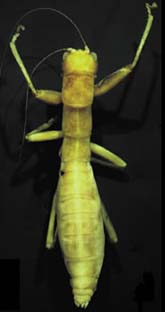New insect order found

Probably the remnants of what was once a larger and more widespread group. <br>© Science <br>
Two cricket-like creatures establish new insect group.
The first new order of insects to be discovered for more than 80 years has emerged from the mountains of Namibia. The order’s first official members are two creatures about 2 cm long that look a bit like a cross between a cricket and a stick insect1.
The group, called Mantophasmatodea, joins the other 30 or so insect orders such as beetles, flies and termites. “If it was in mammals it’d be like discovering bats,” says Dick Vane-Wright, head of entomology at London’s Natural History Museum.
Klaus Klass, of the University of Copenhagen, Denmark, and his colleagues unearthed specimens languishing unidentified in museums, found fossils preserved in amber, and discovered living insects on a trip to Namibia. Now the team has published a description of two species. Three or four more await description, says Klass.
The living Mantophasmatodea dwell in grass on a mountaintop. They seem to be predators – their stomachs contained remains of other insects.
The fossil Mantophasmatodea are 40-50 million years old, some come from Europe. This implies that the African insects are the remnants of what was once a larger and more widespread group.
Vane-Wright compares the insects to the Coelacanth, the ’living fossil’ fish recently rediscovered in the Indian Ocean. “Mantophasmatodea might be a major group on the verge of extinction, or it might just have been overlooked,” he says.
An order is one of the higher categories used to group species – we of the species homo sapiens belong to the order primates, for example. Biologists define such categories by identifying sets of characteristics shared by a group of species but not found in any other group.
Group dynamics
The Mantophasmatodea’s relation to other insects is uncertain. Klass and his colleagues suspect that they are closest to the stick insects and a small group called the Grylloblattodea, found on mountaintops in North America and Asia. Grylloblattodea was the last new order discovered, in 1914.
Sequencing the insects’ DNA might clarify their place in the tree of life. Evolutionary biologist Michael Whiting, of Brigham Young University, Provo, Utah, is doing this at the moment. But we shouldn’t expect cut-and-dried answers, he says.
“We’ve known about the other orders for centuries, and we still haven’t worked out their relationships,” Whiting says. “This is one more piece of a large and complex puzzle: it’s exciting to have the piece, but it’s not going to provide the answer by itself.”
References
- Klass, K.-D., Zompro, O., Kristensen, N.P. & Adis, J. Mantophasmatodea: a new insect order with extant members in the Afrotropics. Science Published online(2002).
Media Contact
All latest news from the category: Life Sciences and Chemistry
Articles and reports from the Life Sciences and chemistry area deal with applied and basic research into modern biology, chemistry and human medicine.
Valuable information can be found on a range of life sciences fields including bacteriology, biochemistry, bionics, bioinformatics, biophysics, biotechnology, genetics, geobotany, human biology, marine biology, microbiology, molecular biology, cellular biology, zoology, bioinorganic chemistry, microchemistry and environmental chemistry.
Newest articles

Properties of new materials for microchips
… can now be measured well. Reseachers of Delft University of Technology demonstrated measuring performance properties of ultrathin silicon membranes. Making ever smaller and more powerful chips requires new ultrathin…

Floating solar’s potential
… to support sustainable development by addressing climate, water, and energy goals holistically. A new study published this week in Nature Energy raises the potential for floating solar photovoltaics (FPV)…

Skyrmions move at record speeds
… a step towards the computing of the future. An international research team led by scientists from the CNRS1 has discovered that the magnetic nanobubbles2 known as skyrmions can be…





















